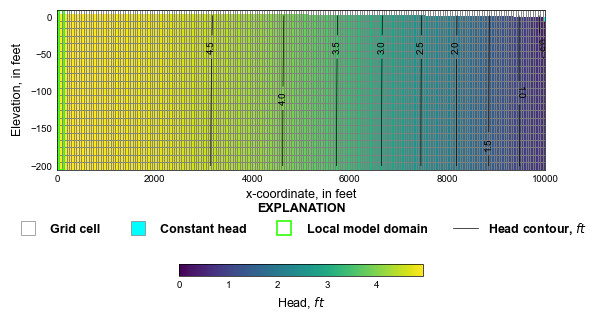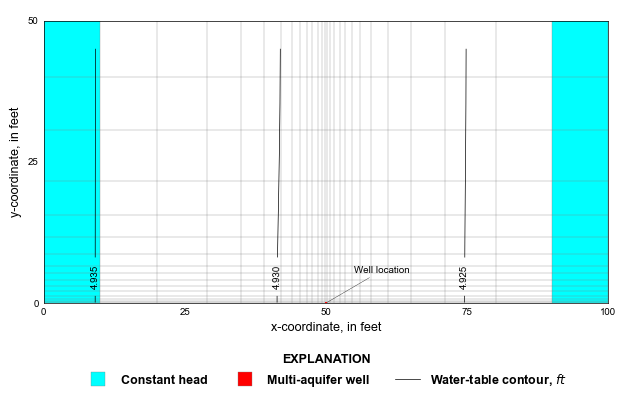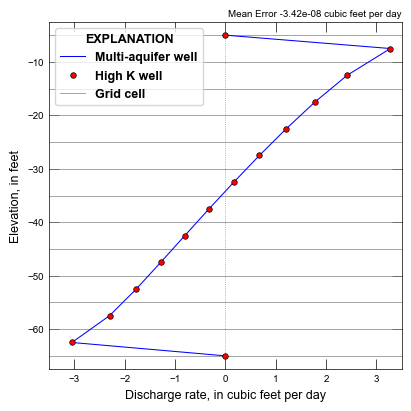This page was generated from
ex-gwf-maw-p03.py.
It's also available as a notebook.
Reilly multi-aquifer well example
This is the multi-aquifer well example from Reilly and others (1989).
Initial setup
Import dependencies, define the example name and workspace, and read settings from environment variables.
[1]:
import os
import pathlib as pl
import flopy
import git
import matplotlib.pyplot as plt
import numpy as np
from flopy.plot.styles import styles
from modflow_devtools.misc import get_env, timed
# Example name and workspace paths. If this example is running
# in the git repository, use the folder structure described in
# the README. Otherwise just use the current working directory.
sim_name = "ex-gwf-maw-p03"
try:
root = pl.Path(git.Repo(".", search_parent_directories=True).working_dir)
except:
root = None
workspace = root / "examples" if root else pl.Path.cwd()
figs_path = root / "figures" if root else pl.Path.cwd()
# Settings from environment variables
write = get_env("WRITE", True)
run = get_env("RUN", True)
plot = get_env("PLOT", True)
plot_show = get_env("PLOT_SHOW", True)
plot_save = get_env("PLOT_SAVE", True)
Define parameters
Define model units, parameters and other settings.
[2]:
# Model units
length_units = "feet"
time_units = "days"
# Scenario-specific parameters
parameters = {
"ex-gwf-maw-p03a": {
"simulation": "regional",
},
"ex-gwf-maw-p03b": {
"simulation": "multi-aquifer well",
},
"ex-gwf-maw-p03c": {
"simulation": "high conductivity",
},
}
# function to calculate the well connection conductance
def calc_cond(area, l1, l2, k1, k2):
c1 = area * k1 / l1
c2 = area * k2 / l2
return c1 * c2 / (c1 + c2)
# Model parameters
nper = 1 # Number of periods
nlay_r = 21 # Number of layers (regional)
nrow_r = 1 # Number of rows (regional)
ncol_r = 200 # Number of columns (regional)
nlay = 41 # Number of layers (local)
nrow = 16 # Number of rows (local)
ncol = 27 # Number of columns (local)
delr_r = 50.0 # Regional column width ($ft$)
delc_r = 1.0 # Regional row width ($ft$)
top = 10.0 # Top of the model ($ft$)
aq_bottom = -205.0 # Model bottom elevation ($ft$)
strt = 10.0 # Starting head ($ft$)
k11 = 250.0 # Horizontal hydraulic conductivity ($ft/d$)
k33 = 50.0 # Vertical hydraulic conductivity ($ft/d$)
recharge = 0.004566 # Areal recharge ($ft/d$)
H1 = 0.0 # Regional downgradient constant head ($ft$)
maw_loc = (15, 13) # Row, column location of well
maw_lay = (1, 12) # Layers with well screen
maw_radius = 0.1333 # Well radius ($ft$)
maw_bot = -65.0 # Bottom of the well ($ft$)
maw_highK = 1e9 # Hydraulic conductivity for well ($ft/d$)
# set delr and delc for the local model
delr = [
10.0,
10.0,
9.002,
6.0,
4.0,
3.0,
2.0,
1.33,
1.25,
1.00,
1.00,
0.75,
0.50,
0.333,
0.50,
0.75,
1.00,
1.00,
1.25,
1.333,
2.0,
3.0,
4.0,
6.0,
9.002,
10.0,
10.0,
]
delc = [
10,
9.38,
9,
6,
4,
3,
2,
1.33,
1.25,
1,
1,
0.75,
0.5,
0.3735,
0.25,
0.1665,
]
# Time discretization
tdis_ds = ((1.0, 1, 1.0),)
# Define dimensions
extents = (0.0, np.array(delr).sum(), 0.0, np.array(delc).sum())
shape2d = (nrow, ncol)
shape3d = (nlay, nrow, ncol)
# MAW Package boundary conditions
nconn = 2 + 3 * (maw_lay[1] - maw_lay[0] + 1)
maw_packagedata = [[0, maw_radius, maw_bot, strt, "SPECIFIED", nconn]]
# Build the MAW connection data
i, j = maw_loc
obs_elev = {}
maw_conn = []
gwf_obs = []
for k in range(maw_lay[0], maw_lay[1] + 1, 1):
gwf_obs.append([f"H0_{k}", "HEAD", (k, i, j)])
maw_obs = [
["H0", "HEAD", (0,)],
]
iconn = 0
z = -5.0
for k in range(maw_lay[0], maw_lay[1] + 1, 1):
# connection to layer below
if k == maw_lay[0]:
area = delc[i] * delr[j]
l1 = 2.5
l2 = 2.5
cond = calc_cond(area, l1, l2, k33, maw_highK)
maw_conn.append([0, iconn, k - 1, i, j, top, maw_bot, cond, -999.0])
tag = f"Q{iconn:02d}"
obs_elev[tag] = z
maw_obs.append([tag, "maw", (0,), (iconn,)])
gwf_obs.append([tag, "flow-ja-face", (k, i, j), (k - 1, i, j)])
iconn += 1
z -= 2.5
# connection to left
area = delc[i] * 5.0
l1 = 0.5 * delr[j]
l2 = 0.5 * delr[j - 1]
cond = calc_cond(area, l1, l2, maw_highK, k11)
maw_conn.append([0, iconn, k, i, j - 1, top, maw_bot, cond, -999.0])
tag = f"Q{iconn:02d}"
obs_elev[tag] = z
maw_obs.append([tag, "maw", (0,), (iconn,)])
gwf_obs.append([tag, "flow-ja-face", (k, i, j), (k, i, j - 1)])
iconn += 1
# connection to north
area = delr[j] * 5.0
l1 = 0.5 * delc[i]
l2 = 0.5 * delc[i - 1]
cond = calc_cond(area, l1, l2, maw_highK, k11)
maw_conn.append([0, iconn, k, i - 1, j, top, maw_bot, cond, -999.0])
tag = f"Q{iconn:02d}"
obs_elev[tag] = z
maw_obs.append([tag, "maw", (0,), (iconn,)])
gwf_obs.append([tag, "flow-ja-face", (k, i, j), (k, i - 1, j)])
iconn += 1
# connection to right
area = delc[i] * 5.0
l1 = 0.5 * delr[j]
l2 = 0.5 * delr[j + 1]
cond = calc_cond(area, l1, l2, maw_highK, k11)
maw_conn.append([0, iconn, k, i, j + 1, top, maw_bot, cond, -999.0])
tag = f"Q{iconn:02d}"
obs_elev[tag] = z
maw_obs.append([tag, "maw", (0,), (iconn,)])
gwf_obs.append([tag, "flow-ja-face", (k, i, j), (k, i, j + 1)])
iconn += 1
z -= 5.0
# connection to layer below
if k == maw_lay[1]:
z += 2.5
area = delc[i] * delr[j]
l1 = 2.5
l2 = 2.5
cond = calc_cond(area, l1, l2, maw_highK, k33)
maw_conn.append([0, iconn, k + 1, i, j, top, maw_bot, cond, -999.0])
tag = f"Q{iconn:02d}"
obs_elev[tag] = z
maw_obs.append([tag, "maw", (0,), (iconn,)])
gwf_obs.append([tag, "flow-ja-face", (k, i, j), (k + 1, i, j)])
iconn += 1
# Solver parameters
nouter = 500
ninner = 100
hclose = 1e-9
rclose = 1e-4
Model setup
Define functions to build models, write input files, and run the simulation.
[3]:
def build_models(name, simulation="regional"):
if simulation == "regional":
return build_regional(name)
else:
return build_local(name, simulation)
def build_regional(name):
sim_ws = os.path.join(workspace, name)
sim = flopy.mf6.MFSimulation(sim_name=sim_name, sim_ws=sim_ws, exe_name="mf6")
flopy.mf6.ModflowTdis(sim, nper=nper, perioddata=tdis_ds, time_units=time_units)
flopy.mf6.ModflowIms(
sim,
print_option="summary",
outer_maximum=nouter,
outer_dvclose=hclose,
inner_maximum=ninner,
inner_dvclose=hclose,
rcloserecord=f"{rclose} strict",
)
botm = np.arange(-5, aq_bottom - 10.0, -10.0)
icelltype = [1] + [0 for k in range(1, nlay_r)]
gwf = flopy.mf6.ModflowGwf(sim, modelname=sim_name)
flopy.mf6.ModflowGwfdis(
gwf,
length_units=length_units,
nlay=nlay_r,
nrow=nrow_r,
ncol=ncol_r,
delr=delr_r,
delc=delc_r,
top=top,
botm=botm,
)
flopy.mf6.ModflowGwfnpf(
gwf,
icelltype=icelltype,
k=k11,
k33=k33,
)
flopy.mf6.ModflowGwfic(gwf, strt=strt)
flopy.mf6.ModflowGwfchd(gwf, stress_period_data=[[0, 0, ncol_r - 1, 0.0]])
flopy.mf6.ModflowGwfrcha(gwf, recharge=recharge)
head_filerecord = f"{sim_name}.hds"
flopy.mf6.ModflowGwfoc(
gwf,
head_filerecord=head_filerecord,
saverecord=[("HEAD", "LAST")],
printrecord=[("BUDGET", "LAST")],
)
return sim
def build_local(name, simulation):
# get regional heads for constant head boundaries
pth = list(parameters.keys())[0]
fpth = os.path.join(workspace, pth, f"{sim_name}.hds")
try:
h = flopy.utils.HeadFile(fpth).get_data()
except:
h = np.ones((nlay_r, nrow_r, ncol_r), dtype=float) * strt
# calculate factor for constant heads
f1 = 0.5 * (delr_r + delr[0]) / delc_r
f2 = 0.5 * (delr_r + delr[-1]) / delc_r
# build chd for model
regional_range = [k for k in range(nlay_r)]
local_range = [[0]] + [[k, k + 1] for k in range(1, nlay, 2)]
chd_spd = []
for kr, kl in zip(regional_range, local_range):
h1 = h[kr, 0, 0]
h2 = h[kr, 0, 1]
hi1 = h1 + f1 * (h2 - h1)
h1 = h[kr, 0, 2]
h2 = h[kr, 0, 3]
hi2 = h1 + f2 * (h2 - h1)
for k in kl:
for il in range(nrow):
chd_spd.append([k, il, 0, hi1])
chd_spd.append([k, il, ncol - 1, hi2])
sim_ws = os.path.join(workspace, name)
sim = flopy.mf6.MFSimulation(sim_name=sim_name, sim_ws=sim_ws, exe_name="mf6")
flopy.mf6.ModflowTdis(sim, nper=nper, perioddata=tdis_ds, time_units=time_units)
flopy.mf6.ModflowIms(
sim,
print_option="summary",
outer_maximum=nouter,
outer_dvclose=hclose,
inner_maximum=ninner,
inner_dvclose=hclose,
rcloserecord=f"{rclose} strict",
)
gwf = flopy.mf6.ModflowGwf(sim, modelname=sim_name, save_flows=True)
botm = np.arange(-5, aq_bottom - 5.0, -5.0)
icelltype = [1] + [0 for k in range(1, nlay)]
i, j = maw_loc
if simulation == "multi-aquifer well":
k11_sim = k11
k33_sim = k33
idomain = np.ones(shape3d, dtype=float)
for k in range(maw_lay[0], maw_lay[1] + 1, 1):
idomain[k, i, j] = 0
else:
k11_sim = np.ones(shape3d, dtype=float) * k11
k33_sim = np.ones(shape3d, dtype=float) * k33
idomain = 1
for k in range(maw_lay[0], maw_lay[1] + 1, 1):
k11_sim[k, i, j] = maw_highK
k33_sim[k, i, j] = maw_highK
flopy.mf6.ModflowGwfdis(
gwf,
length_units=length_units,
nlay=nlay,
nrow=nrow,
ncol=ncol,
delr=delr,
delc=delc,
top=top,
botm=botm,
idomain=idomain,
)
flopy.mf6.ModflowGwfnpf(
gwf,
icelltype=icelltype,
k=k11_sim,
k33=k33_sim,
save_specific_discharge=True,
)
flopy.mf6.ModflowGwfic(gwf, strt=strt)
flopy.mf6.ModflowGwfchd(gwf, stress_period_data=chd_spd)
flopy.mf6.ModflowGwfrcha(gwf, recharge=recharge)
if simulation == "multi-aquifer well":
maw = flopy.mf6.ModflowGwfmaw(
gwf,
no_well_storage=True,
nmawwells=1,
packagedata=maw_packagedata,
connectiondata=maw_conn,
)
obs_file = f"{sim_name}.maw.obs"
csv_file = obs_file + ".csv"
obs_dict = {csv_file: maw_obs}
maw.obs.initialize(
filename=obs_file, digits=10, print_input=True, continuous=obs_dict
)
else:
obs_file = f"{sim_name}.gwf.obs"
csv_file = obs_file + ".csv"
obsdict = {csv_file: gwf_obs}
flopy.mf6.ModflowUtlobs(
gwf, filename=obs_file, print_input=False, continuous=obsdict
)
head_filerecord = f"{sim_name}.hds"
budget_filerecord = f"{sim_name}.cbc"
flopy.mf6.ModflowGwfoc(
gwf,
head_filerecord=head_filerecord,
budget_filerecord=budget_filerecord,
saverecord=[("HEAD", "LAST"), ("BUDGET", "LAST")],
printrecord=[("BUDGET", "LAST")],
)
return sim
def write_models(sim, silent=True):
sim.write_simulation(silent=silent)
@timed
def run_models(sim, silent=True):
success, buff = sim.run_simulation(silent=silent)
assert success, buff
Plotting results
Define functions to plot model results.
[4]:
# Figure properties
figure_size = (6.3, 4.3)
masked_values = (0, 1e30, -1e30)
arrow_props = dict(facecolor="black", arrowstyle="-", lw=0.25, shrinkA=0.1, shrinkB=0.1)
def plot_maw_results(silent=True):
with styles.USGSPlot():
# load the observations
name = list(parameters.keys())[1]
fpth = os.path.join(workspace, name, f"{sim_name}.maw.obs.csv")
maw = flopy.utils.Mf6Obs(fpth).data
name = list(parameters.keys())[2]
fpth = os.path.join(workspace, name, f"{sim_name}.gwf.obs.csv")
gwf = flopy.utils.Mf6Obs(fpth).data
# process heads
hgwf = 0.0
ihds = 0.0
for name in gwf.dtype.names:
if name.startswith("H0_"):
hgwf += gwf[name]
ihds += 1.0
hgwf /= ihds
if silent:
print("MAW head: {} Average head: {}".format(maw["H0"], hgwf))
zelev = sorted(list(set(list(obs_elev.values()))), reverse=True)
results = {
"maw": {},
"gwf": {},
}
for z in zelev:
results["maw"][z] = 0.0
results["gwf"][z] = 0.0
for name in maw.dtype.names:
if name.startswith("Q"):
z = obs_elev[name]
results["maw"][z] += 2.0 * maw[name]
for name in gwf.dtype.names:
if name.startswith("Q"):
z = obs_elev[name]
results["gwf"][z] += 2.0 * gwf[name]
q0 = np.array(list(results["maw"].values()))
q1 = np.array(list(results["gwf"].values()))
mean_error = np.mean(q0 - q1)
if silent:
print(f"total well inflow: {q0[q0 >= 0].sum()}")
print(f"total well outflow: {q0[q0 < 0].sum()}")
print(f"total cell inflow: {q1[q1 >= 0].sum()}")
print(f"total cell outflow: {q1[q1 < 0].sum()}")
# create the figure
fig, ax = plt.subplots(
ncols=1,
nrows=1,
sharex=True,
figsize=(4, 4),
constrained_layout=True,
)
ax.set_xlim(-3.5, 3.5)
ax.set_ylim(-67.5, -2.5)
ax.axvline(0, lw=0.5, ls=":", color="0.5")
for z in np.arange(-5, -70, -5):
ax.axhline(z, lw=0.5, color="0.5")
ax.plot(
results["maw"].values(),
zelev,
lw=0.75,
ls="-",
color="blue",
label="Multi-aquifer well",
)
ax.plot(
results["gwf"].values(),
zelev,
marker="o",
ms=4,
mfc="red",
mec="black",
markeredgewidth=0.5,
lw=0.0,
ls="-",
color="red",
label="High K well",
)
ax.plot(
-1000,
-1000,
lw=0.5,
ls="-",
color="0.5",
label="Grid cell",
)
styles.graph_legend(ax, loc="upper left", ncol=1, frameon=True)
styles.add_text(
ax,
f"Mean Error {mean_error:.2e} cubic feet per day",
bold=False,
italic=False,
x=1.0,
y=1.01,
va="bottom",
ha="right",
fontsize=7,
)
ax.set_xlabel("Discharge rate, in cubic feet per day")
ax.set_ylabel("Elevation, in feet")
if plot_show:
plt.show()
if plot_save:
fpth = figs_path / f"{sim_name}-01.png"
fig.savefig(fpth)
def plot_regional_grid(silent=True):
if silent:
verbosity = 0
else:
verbosity = 1
name = list(parameters.keys())[0]
sim_ws = os.path.join(workspace, name)
sim = flopy.mf6.MFSimulation.load(
sim_name=sim_name, sim_ws=sim_ws, verbosity_level=verbosity
)
gwf = sim.get_model(sim_name)
# get regional heads for constant head boundaries
h = gwf.output.head().get_data()
with styles.USGSMap() as fs:
fig = plt.figure(
figsize=(6.3, 3.5),
)
plt.axis("off")
nrows, ncols = 10, 1
axes = [fig.add_subplot(nrows, ncols, (1, 6))]
# legend axis
axes.append(fig.add_subplot(nrows, ncols, (7, 10)))
# set limits for legend area
ax = axes[-1]
ax.set_xlim(0, 1)
ax.set_ylim(0, 1)
# get rid of ticks and spines for legend area
ax.axis("off")
ax.set_xticks([])
ax.set_yticks([])
ax.spines["top"].set_color("none")
ax.spines["bottom"].set_color("none")
ax.spines["left"].set_color("none")
ax.spines["right"].set_color("none")
ax.patch.set_alpha(0.0)
ax = axes[0]
mm = flopy.plot.PlotCrossSection(gwf, ax=ax, line={"row": 0})
ca = mm.plot_array(h, head=h)
mm.plot_bc("CHD", color="cyan", head=h)
mm.plot_grid(lw=0.5, color="0.5")
cv = mm.contour_array(
h,
levels=np.arange(0, 6, 0.5),
linewidths=0.5,
linestyles="-",
colors="black",
masked_values=masked_values,
)
plt.clabel(cv, fmt="%1.1f")
ax.plot(
[50, 150, 150, 50, 50],
[10, 10, aq_bottom, aq_bottom, 10],
lw=1.25,
color="#39FF14",
)
styles.remove_edge_ticks(ax)
ax.set_xlabel("x-coordinate, in feet")
ax.set_ylabel("Elevation, in feet")
# legend
ax = axes[-1]
ax.plot(
-10000,
-10000,
lw=0,
marker="s",
ms=10,
mfc="none",
mec="0.5",
markeredgewidth=0.5,
label="Grid cell",
)
ax.plot(
-10000,
-10000,
lw=0,
marker="s",
ms=10,
mfc="cyan",
mec="0.5",
markeredgewidth=0.5,
label="Constant head",
)
ax.plot(
-10000,
-10000,
lw=0,
marker="s",
ms=10,
mfc="none",
mec="#39FF14",
markeredgewidth=1.25,
label="Local model domain",
)
ax.plot(
-10000,
-10000,
lw=0.5,
color="black",
label="Head contour, $ft$",
)
cbar = plt.colorbar(ca, shrink=0.5, orientation="horizontal", ax=ax)
cbar.ax.tick_params(size=0)
cbar.ax.set_xlabel(r"Head, $ft$", fontsize=9)
styles.graph_legend(ax, loc="lower center", ncol=4)
if plot_show:
plt.show()
if plot_save:
fpth = figs_path / f"{sim_name}-regional-grid.png"
fig.savefig(fpth)
def plot_local_grid(silent=True):
if silent:
verbosity = 0
else:
verbosity = 1
name = list(parameters.keys())[1]
sim_ws = os.path.join(workspace, name)
sim = flopy.mf6.MFSimulation.load(
sim_name=sim_name, sim_ws=sim_ws, verbosity_level=verbosity
)
gwf = sim.get_model(sim_name)
i, j = maw_loc
dx, dy = delr[j], delc[i]
px = (
50.0 - 0.5 * dx,
50.0 + 0.5 * dx,
)
py = (
0.0 + dy,
0.0 + dy,
)
# get regional heads for constant head boundaries
h = gwf.output.head().get_data()
with styles.USGSMap() as fs:
fig = plt.figure(
figsize=(6.3, 4.1),
tight_layout=True,
)
plt.axis("off")
nrows, ncols = 10, 1
axes = [fig.add_subplot(nrows, ncols, (1, 8))]
for idx, ax in enumerate(axes):
ax.set_xlim(extents[:2])
ax.set_ylim(extents[2:])
ax.set_aspect("equal")
# legend axis
axes.append(fig.add_subplot(nrows, ncols, (8, 10)))
# set limits for legend area
ax = axes[-1]
ax.set_xlim(0, 1)
ax.set_ylim(0, 1)
# get rid of ticks and spines for legend area
ax.axis("off")
ax.set_xticks([])
ax.set_yticks([])
ax.spines["top"].set_color("none")
ax.spines["bottom"].set_color("none")
ax.spines["left"].set_color("none")
ax.spines["right"].set_color("none")
ax.patch.set_alpha(0.0)
ax = axes[0]
mm = flopy.plot.PlotMapView(gwf, ax=ax, extent=extents, layer=0)
mm.plot_bc("CHD", color="cyan", plotAll=True)
mm.plot_grid(lw=0.25, color="0.5")
cv = mm.contour_array(
h,
levels=np.arange(4.0, 5.0, 0.005),
linewidths=0.5,
linestyles="-",
colors="black",
masked_values=masked_values,
)
plt.clabel(cv, fmt="%1.3f")
ax.fill_between(
px, py, y2=0, ec="none", fc="red", lw=0, zorder=200, step="post"
)
styles.add_annotation(
ax,
text="Well location",
xy=(50.0, 0.0),
xytext=(55, 5),
bold=False,
italic=False,
ha="left",
fontsize=7,
arrowprops=arrow_props,
)
styles.remove_edge_ticks(ax)
ax.set_xticks([0, 25, 50, 75, 100])
ax.set_xlabel("x-coordinate, in feet")
ax.set_yticks([0, 25, 50])
ax.set_ylabel("y-coordinate, in feet")
# legend
ax = axes[-1]
ax.plot(
-10000,
-10000,
lw=0,
marker="s",
ms=10,
mfc="cyan",
mec="0.5",
markeredgewidth=0.25,
label="Constant head",
)
ax.plot(
-10000,
-10000,
lw=0,
marker="s",
ms=10,
mfc="red",
mec="0.5",
markeredgewidth=0.25,
label="Multi-aquifer well",
)
ax.plot(
-10000,
-10000,
lw=0.5,
color="black",
label="Water-table contour, $ft$",
)
styles.graph_legend(ax, loc="lower center", ncol=3)
if plot_show:
plt.show()
if plot_save:
fpth = figs_path / f"{sim_name}-local-grid.png"
fig.savefig(fpth)
def plot_results(silent=True):
if not plot:
return
plot_regional_grid(silent=silent)
plot_local_grid(silent=silent)
plot_maw_results(silent=silent)
Running the example
Define and invoke a function to run the example scenario, then plot results.
[5]:
def scenario(idx=0, silent=True):
key = list(parameters.keys())[idx]
params = parameters[key].copy()
sim = build_models(key, **params)
if write:
write_models(sim, silent=silent)
if run:
run_models(sim, silent=silent)
Run the regional model.
[6]:
scenario(0)
<flopy.mf6.data.mfstructure.MFDataItemStructure object at 0x7f69ebc6b880>
run_models took 116.99 ms
Run the local model with MAW well.
[7]:
scenario(1)
<flopy.mf6.data.mfstructure.MFDataItemStructure object at 0x7f69ebc6b880>
run_models took 213.86 ms
Run the local model with high K well.
[8]:
scenario(2)
<flopy.mf6.data.mfstructure.MFDataItemStructure object at 0x7f69ebc6b880>
run_models took 215.38 ms
Plot the results.
[9]:
if plot:
plot_results()


MAW head: [4.92585447] Average head: [4.92585437]
total well inflow: 9.531058122288
total well outflow: -9.531057706696
total cell inflow: 9.520740053609773
total cell outflow: -9.520739158950668
